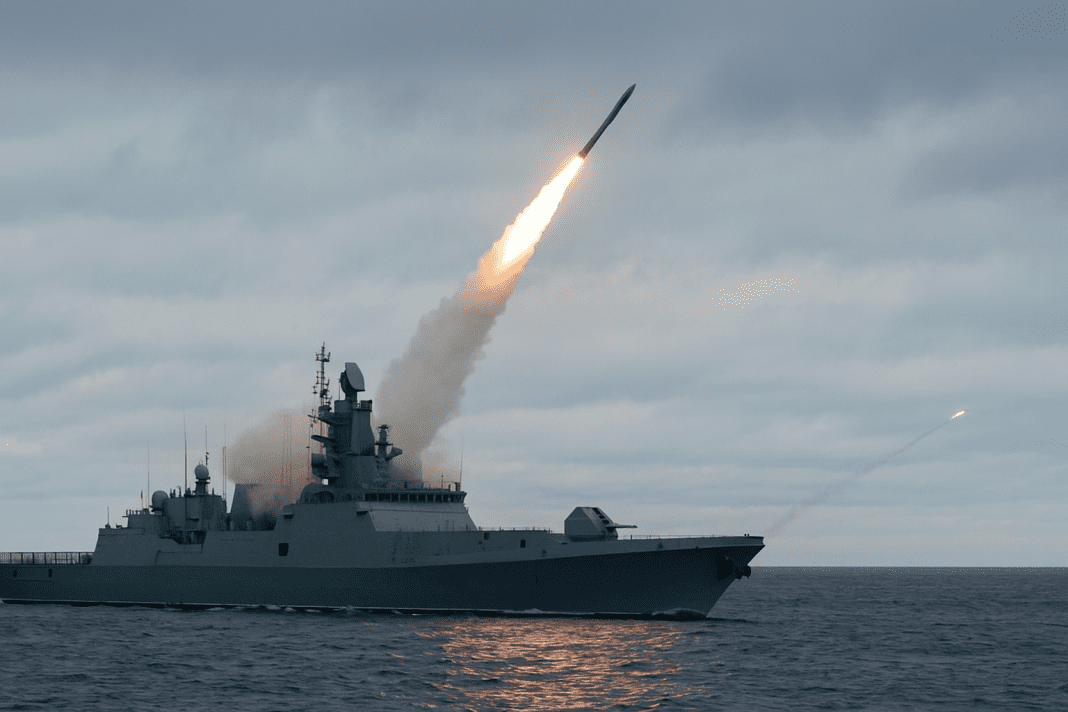The Russian Navy carried out a powerful military exercise in the Sea of Japan that highlighted its long-range strike capabilities. A key part of this drill was the involvement of the frigate Marshal Shaposhnikov, which successfully test fired two types of cruise missiles – the Kalibr cruise and Uran.
Kalibr Cruise Missile Drill In The Sea Of Japan
The Kalibr cruise missile demonstrates precision and long-range capabilities, making it one of the most widely used modern weapons in Russia’s arsenal. The Uran missile, on the other hand, targets ships at sea and gives the navy a sharp edge in naval warfare. During the exercise, the frigate launched both missile systems, creating a striking display of coordination and military readiness.
The defence ministry released official footage that showed the frigate preparing for launch, with sailors calmly issuing commands. Soon after, the missiles streaked into the sky, cut across the horizon, and struck their designated targets. The ministry confirmed that the missiles hit all targets successfully, showcasing both the accuracy and the effectiveness of the weapons.
Cruise Missile Test Propels Japan’s Military Might
The Pacific Fleet expanded the drills beyond just the frigate and its missiles. It deployed other naval vessels and aircraft to support the manoeuvres. The fleet also used drones as part of the exercise, highlighting how modern military operations combine multiple technologies at once.
Role Of The Pacific Fleet And Kalibr Cruise Power
The Pacific Fleet plays a vital role in Russia’s military presence in the Far East. During this exercise, its ships, aircraft, and drones were all involved in the joint training. The scale of the drill demonstrated how different parts of the navy work together during complex operations.
By combining surface ships like the Marshal Shaposhnikov with naval aviation and unmanned systems, the drill simulated a coordinated strike scenario. In such drills, precision and timing are critical. Each missile must be launched and tracked carefully, while aircraft and drones provide support from above.
The Kalibr cruise missile, already tested in various environments in the past, has proven its ability to strike targets far from the launch site. Meanwhile, the Uran missile’s role is more specific – it is used to engage enemy ships directly. Launching both types of missiles in one exercise allowed the Pacific Fleet to display a wide range of capabilities, from land-attack missions to naval warfare.
Frightening Kalibr Missiles Arm Russian Warships Imperiling Crimea
Official footage of the drill showed how sailors on board worked in harmony. Their calm and professional execution of orders gave a glimpse into the training and discipline that such operations require. The Pacific Fleet’s combined involvement with advanced technology painted a clear picture of how Russia conducts modern naval drills.
The inclusion of the Kalibr cruise missile in this exercise gave the fleet a chance to showcase not only its power but also its flexibility in dealing with different types of threats. With its precision strike capability, the Kalibr cruise has become a central weapon in the fleet’s arsenal.
Regional Context And Japan’s Defence Debate
This display of naval power comes at a time when discussions around defence and security are becoming more prominent in the region. In Japan, there has been an active debate about the country’s defence policies and its long-standing principles regarding nuclear weapons.
Reports earlier this month indicated that some voices in Japan are more open to reconsidering the strict policy known as the “Three Non-Nuclear Principles.” These principles have guided the country for decades, with a clear stance against producing, possessing, or hosting nuclear weapons. The shift in discussion shows how the regional security environment is closely tied to demonstrations of military power such as this drill.
Russia confirms continued missile development during deployment moratorium
The Sea of Japan, where these missile tests took place, is an important and sensitive waterway. Military activities in this region are closely watched, as they can directly affect the balance of security in Northeast Asia. Russia’s choice to conduct such drills here signals the importance it places on demonstrating its strike capabilities.
For observers, the sight of the Kalibr cruise and Uran missiles streaking across the Sea of Japan served as a reminder of the powerful tools that modern navies possess. With aircraft, drones, and warships all playing their part, the exercise reflected the complexity of modern military operations at sea.
